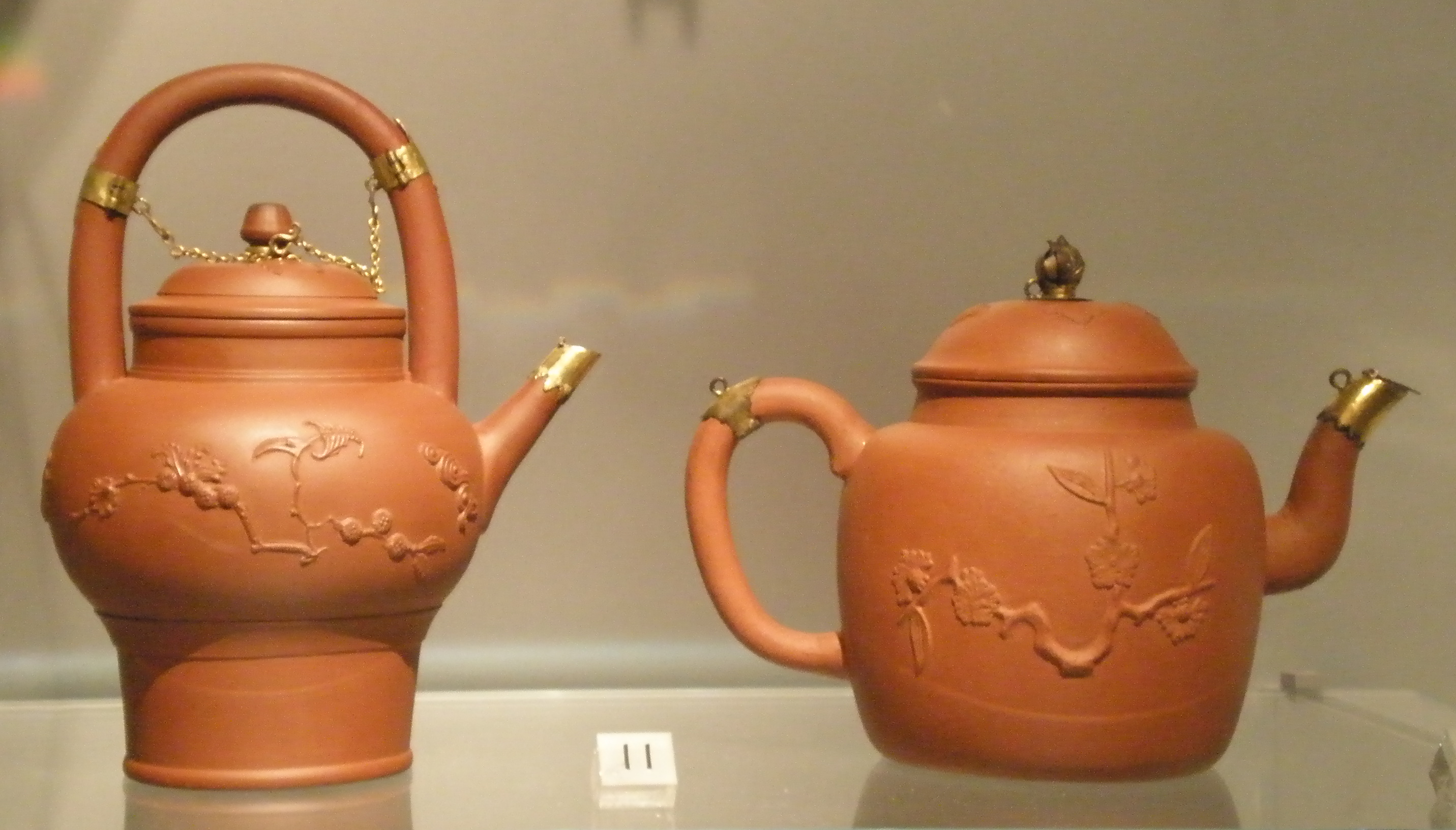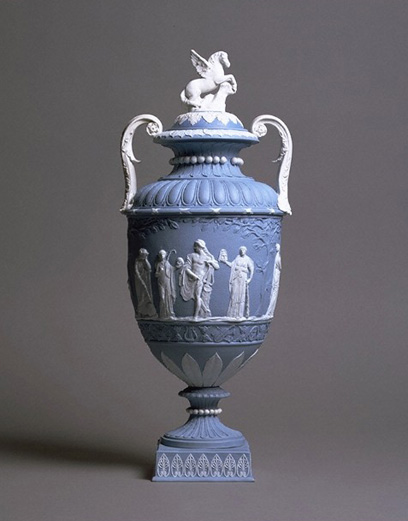|
Redware
Redware as a single word is a term for at least two types of pottery of the last few centuries, in Europe and North America. Red ware as two words is a term used for pottery, mostly by archaeologists, found in a very wide range of places. However, these distinct usages are not always adhered to, especially when referring to the many different types of pre-colonial red wares in the Americas, which may be called "redware". In the great majority of cases the "red" concerned is the natural reddish-brown of the fired clay, and the same sort of colour as in terracotta (which most types of red ware could also be called) or red brick. The colour to which clay turns when fired varies considerably with its geological makeup and the conditions of firing, and as well as terracotta red, covers a wide range of blacks, browns, greys, whites and yellows. Of the two "redware" types, both made between the 17th to 19th centuries (with modern revivals or imitations), the European was unglazed s ... [...More Info...] [...Related Items...] OR: [Wikipedia] [Google] [Baidu] |
Stoneware
Stoneware is a rather broad term for pottery or other ceramics fired at a relatively high temperature. A modern technical definition is a vitreous or semi-vitreous ceramic made primarily from stoneware clay or non- refractory fire clay. Whether vitrified or not, it is nonporous (does not soak up liquids);Arthur Dodd & David Murfin. ''Dictionary of Ceramics''; 3rd edition. The Institute of Minerals, 1994. it may or may not be glazed. Historically, around the world, it has been developed after earthenware and before porcelain, and has often been used for high-quality as well as utilitarian wares. As a rough guide, modern earthenwares are normally fired in a kiln at temperatures in the range of about 1,000 ° C (1,830 °F) to ; stonewares at between about to ; and porcelains at between about to . Historically, reaching high temperatures was a long-lasting challenge, and temperatures somewhat below these were used for a long time. Earthenware can be fired effectively as low as 6 ... [...More Info...] [...Related Items...] OR: [Wikipedia] [Google] [Baidu] |
John Philip Elers
John Philip Elers (7 September 1664 – 1738) and his brother David Elers were Dutch silversmiths who came to England in the 1680s and turned into potters. The Elers brothers were important innovators in English pottery, bringing redware or unglazed stoneware to Staffordshire pottery. Arguably they were the first producers of "fine pottery" in North Staffordshire, and although their own operations were not financially successful, they seem to have had a considerable influence on the following generation, who led the explosive growth of the industry in the 18th century. The difficulty of distinguishing their wares from those of the many imitators who continued their broad style well into the 18th century has long been recognised by scholars, though considerable progress has been made, based on an understanding of their distinctive technique. The works of the imitators are often described as "Elers type", "style of Elers", and similar terms. Potters After moving to London, Davi ... [...More Info...] [...Related Items...] OR: [Wikipedia] [Google] [Baidu] |
Jasperware
Jasperware, or jasper ware, is a type of pottery first developed by Josiah Wedgwood in the 1770s. Usually described as stoneware, it has an unglazed matte "biscuit" finish and is produced in a number of different colours, of which the most common and best known is a pale blue that has become known as Wedgwood Blue. Relief decorations in contrasting colours (typically in white but also in other colours) are characteristic of jasperware, giving a cameo effect. The reliefs are produced in moulds and applied to the ware as sprigs. After several years of experiments, Wedgwood began to sell jasperware in the late 1770s, at first as small objects, but from the 1780s adding large vases. It was extremely popular, and after a few years many other potters devised their own versions. Wedgwood continued to make it into the 21st century. The decoration was initially in the fashionable Neoclassical style, which was often used in the following centuries, but it could be made to suit other ... [...More Info...] [...Related Items...] OR: [Wikipedia] [Google] [Baidu] |
Red Polished Ware (other) - various types of pottery with a red or terracotta-coloured body.
{{disambiguation ...
Red Polished Ware may refer to several types of ancient pottery with a red or terracotta-coloured body: * El-Badari, Egypt c. 5500-4000 BC *Philia culture, Cyprus c. 2000 BC * Pottery of ancient Cyprus, Cyprus c. 2000 BC * Red Polished Ware (Gujarat), India c. 300 BC-1000 AD * Terra sigillata#Roman red gloss pottery (Samian ware) Rome; not capitalized See also *Redware Redware as a single word is a term for at least two types of pottery of the last few centuries, in Europe and North America. Red ware as two words is a term used for pottery, mostly by archaeologists, found in a very wide range of places. Howeve ... [...More Info...] [...Related Items...] OR: [Wikipedia] [Google] [Baidu] |
Norwalk, Connecticut
, image_map = Fairfield County Connecticut incorporated and unincorporated areas Norwalk highlighted.svg , mapsize = 230px , map_caption = Location in Fairfield County and Connecticut , coordinates = , pushpin_map = USA#Connecticut , pushpin_label_position = top , pushpin_label = Norwalk , pushpin_map_caption = Location in the United States and Connecticut , subdivision_type = Country , subdivision_name = , subdivision_type1 = U.S. state , subdivision_name1 = , subdivision_type2 = County , subdivision_name2 = Fairfield , subdivision_type3 = Region , subdivision_name3 = Western CT , established_title = Settled , established_date = February 26, 1640 , established_title2 = Incorporated , established_date2 = September 11, 1651 , established_title3 = Consolidated , established_date3 = June 6, 1913 , founder ... [...More Info...] [...Related Items...] OR: [Wikipedia] [Google] [Baidu] |
Northampton County, Pennsylvania
Northampton County is a county in the Commonwealth of Pennsylvania. As of the 2020 census, the population was 312,951. Its county seat is Easton. The county was formed in 1752 from parts of Bucks County. Its namesake was Northamptonshire, England. The county seat of Easton was named for the country house Easton Neston in that shire. Northampton County and Lehigh County to its west combine to form the eastern Pennsylvania region known as the Lehigh Valley, and both counties are included in the Philadelphia media market, the nation's fourth largest media market. Lehigh County, with a population of 374,557 of the 2020 U.S. census, is the more highly populated of the two counties. Northampton County is industrially oriented, producing cement and other industrial products. It was a center for global cement production with the world's then-largest cement producer Atlas Portland Cement Company operating in the county for nearly a century from 1895 until 1982. Bethlehem Steel, on ... [...More Info...] [...Related Items...] OR: [Wikipedia] [Google] [Baidu] |
Sgraffito
''Sgraffito'' (; plural: ''sgraffiti'') is a technique either of wall decor, produced by applying layers of plaster tinted in contrasting colours to a moistened surface, or in pottery, by applying to an unfired ceramic body two successive layers of contrasting slip or glaze, and then in either case scratching so as to reveal parts of the underlying layer. The Italian past participle ''sgraffiato'' is also used, especially of pottery. Etymology The word ''sgraffito'' comes from the Italian language and is derived from ''graffiare'' ("to scratch"), ultimately from the Greek (''gráphein'', "to write"). Related terms include '' graffito'' and ''graffiti''. History Sgraffito on walls has been used in Europe since classical times. It was popularized in Italy in the 15th and 16th centuries and can be found in African art. In combination with ornamental decoration these techniques formed an alternative to the prevailing painting of walls. The technical procedure is relatively sim ... [...More Info...] [...Related Items...] OR: [Wikipedia] [Google] [Baidu] |
Wrightstown, Pennsylvania
Wrightstown is an unincorporated community in Wrightstown Township in Bucks County, Pennsylvania, United States. Wrightstown is located at the intersection of Pennsylvania Route 413 Pennsylvania Route 413 (PA 413) is a , north–south state highway in Bucks County, Pennsylvania. The route runs from the New Jersey state line on the Burlington–Bristol Bridge over the Delaware River outside Bristol, where the road contin ... and Worthington Mill Road/Wrightstown Road. References {{authority control Unincorporated communities in Bucks County, Pennsylvania Unincorporated communities in Pennsylvania ... [...More Info...] [...Related Items...] OR: [Wikipedia] [Google] [Baidu] |
Sherd
In archaeology, a sherd, or more precisely, potsherd, is commonly a historic or prehistoric Prehistory, also known as pre-literary history, is the period of human history between the use of the first stone tools by hominins 3.3 million years ago and the beginning of recorded history with the invention of writing systems. The use of ... fragment of pottery, although the term is occasionally used to refer to fragments of stone and glass vessels, as well. Occasionally, a piece of broken pottery may be referred to as a shard. While the spelling shard is generally reserved for referring to fragments of glass vessels, the term does not exclude pottery fragments. The etymology is connected with the idea of breakage, from Old English ''sceard'', related to Old Norse ''skarð'', "notch", and Middle High German ''schart'', "notch". A sherd or potsherd that has been used by having writing painted or inscribed on it can be more precisely referred to as an ostracon. The analys ... [...More Info...] [...Related Items...] OR: [Wikipedia] [Google] [Baidu] |
Folk Art
Folk art covers all forms of visual art made in the context of folk culture. Definitions vary, but generally the objects have practical utility of some kind, rather than being exclusively decorative. The makers of folk art are typically trained within a popular tradition, rather than in the fine art tradition of the culture. There is often overlap, or contested ground with 'naive art'. "Folk art" is not used in regard to traditional societies where ethnographic art continue to be made. The types of objects covered by the term "folk art" vary. The art form is categorised as "divergent... of cultural production ... comprehended by its usage in Europe, where the term originated, and in the United States, where it developed for the most part along very different lines." For a European perspective, Edward Lucie-Smith described it as "Unsophisticated art, both fine and applied, which is supposedly rooted in the collective awareness of simple people. The concept of folk art ... [...More Info...] [...Related Items...] OR: [Wikipedia] [Google] [Baidu] |







.jpg)